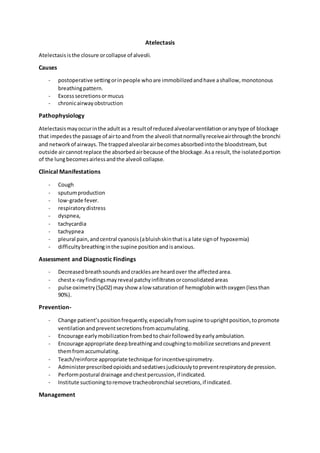Atelectasis.docx
- 1. Atelectasis Atelectasisisthe closure orcollapse of alveoli. Causes - postoperative settingorinpeople whoare immobilizedandhave ashallow,monotonous breathingpattern. - Excesssecretionsormucus - chronicairwayobstruction Pathophysiology Atelectasismayoccurinthe adultas a resultof reducedalveolarventilationoranytype of blockage that impedesthe passage of airtoand from the alveoli thatnormallyreceiveairthroughthe bronchi and networkof airways.The trappedalveolarairbecomesabsorbedintothe bloodstream, but outside aircannotreplace the absorbedairbecause of the blockage.Asa result,the isolatedportion of the lungbecomesairlessandthe alveoli collapse. Clinical Manifestations - Cough - sputumproduction - low-grade fever. - respiratorydistress - dyspnea, - tachycardia - tachypnea - pleural pain,andcentral cyanosis(abluishskinthatisa late signof hypoxemia) - difficultybreathinginthe supine positionandisanxious. Assessment and Diagnostic Findings - Decreasedbreathsoundsandcracklesare heardover the affectedarea. - chestx-rayfindingsmayreveal patchyinfiltratesorconsolidatedareas - pulse oximetry(SpO2) may show alow saturationof hemoglobinwithoxygen(lessthan 90%). Prevention- - Change patientâspositionfrequently,especiallyfromsupine touprightposition,topromote ventilationandpreventsecretionsfromaccumulating. - Encourage earlymobilizationfrombedtochairfollowedbyearlyambulation. - Encourage appropriate deepbreathingandcoughingtomobilize secretionsandprevent themfromaccumulating. - Teach/reinforce appropriate technique forincentivespirometry. - Administerprescribedopioidsandsedativesjudiciouslytopreventrespiratorydepression. - Performpostural drainage andchestpercussion,if indicated. - Institute suctioningtoremove tracheobronchial secretions,if indicated. Management
- 2. - positive expiratorypressure orPEPtherapy(asimple maskandonewayvalve systemthat providesvaryingamountsof expiratoryresistance [usually5to 15 cm H2O]),continuousor intermittentpositive pressure-breathing(IPPB),orbronchoscopymaybe used. - the secretionsmustbe removedbycoughingorsuctioningtopermitairto re-enterthat portion of the lung. - Chestphysical therapy(chestpercussionandpostural drainage) mayalsobe usedto mobilize secretions. - Nebulizertreatmentswithabronchodilatormedicationorsodium - Bronchoscopy - Endotracheal intubationandmechanical ventilation. - Thoracentesis - surgical managementmaybe indicated.

![- positive expiratorypressure orPEPtherapy(asimple maskandonewayvalve systemthat
providesvaryingamountsof expiratoryresistance [usually5to 15 cm H2O]),continuousor
intermittentpositive pressure-breathing(IPPB),orbronchoscopymaybe used.
- the secretionsmustbe removedbycoughingorsuctioningtopermitairto re-enterthat
portion of the lung.
- Chestphysical therapy(chestpercussionandpostural drainage) mayalsobe usedto
mobilize secretions.
- Nebulizertreatmentswithabronchodilatormedicationorsodium
- Bronchoscopy
- Endotracheal intubationandmechanical ventilation.
- Thoracentesis
- surgical managementmaybe indicated.](https://image.slidesharecdn.com/atelectasis-220428174846/85/Atelectasis-docx-2-320.jpg)